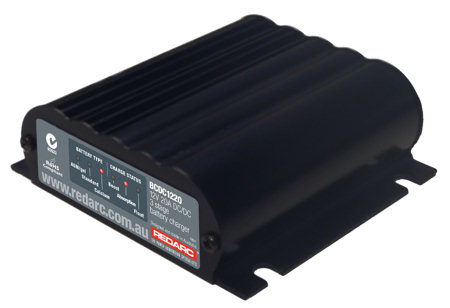|
Redarc BC-DC 1220
install and review

Redarc have just
released a new DC-DC 3 stage 20 amp battery charger. (photos 1 & 2)
http://www.redarc.com.au/dc_battery_chargers_BCDC1220.htm
The great thing about this unit is it will accept anything
from 9 - 32v DC input. That means you can charge the battery on the
camper without having to worry about voltage drop or charge a 12volt
battery from a 24v electrical system.
The unit will
work with a choice of three battery types - AGM/Gel, Calcium Calcium
or Lead acid and uses a three stage charging process to charge the
second battery
http://www.redarc.com.au/pdfs/Specs/BCDC1220InstructionSheet.pdf
and its Australian designed and built with a two year warranty.
The compact size
makes it great for the caravan or camper trailer or for mounting to
a portable battery box. The unit is also sealed so can be mounted
externally or used in a marine application. It also overcomes the
problem with load sensing charging systems and regulated voltage
control charging systems found on some of the more recently released
vehicles.
I installed one of these units into our 2006 Diesel Prado to
charge the Aux battery. The unit is fully sealed so it's fine to
mount under the bonnet. I used the Piranha Battery tray from TJM to
mount the second battery. (see Photo 3) I then installed the
BCDC-1220 on the Driver’s side inner guard, just above the ABS pump.
(Photo 4,5&6)
I am using an 880CCA Calcium battery as my aux, so I was very
keen to see how the unit performed charging the Calcium calcium
battery.
On a recent
camping trip I ran our Engel fridge for two days, and then went for
a couple of hours drive. When I returned to camp the unit had
reached the absorb charge stage. I estimate we possible used about
30 - 40 amp hours of power to run the fridge for the first couple of
days (2.5 days). Another couple of days followed without driving. We
then drove a couple of hours to home and the unit was in float mode
when I lifted the bonnet at home.
I put the volt /
amp meter on it, and grabbed a couple of shots of the input and
output voltage and amps when running a “test” scenario at home.
(Photos 7 -14)
thanks to Rod
Luhrs for sharing the install with us
November 2009
|